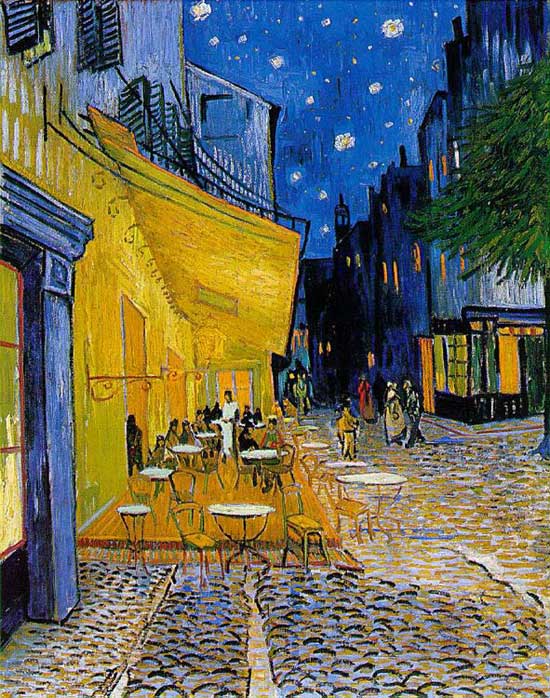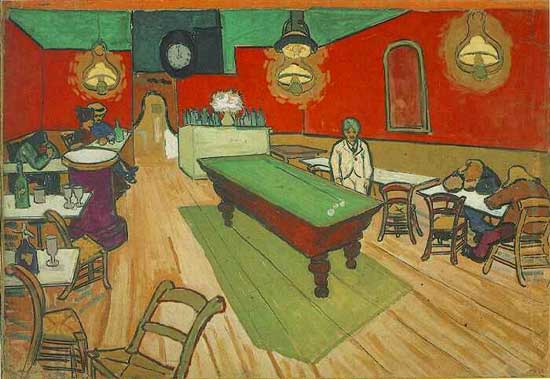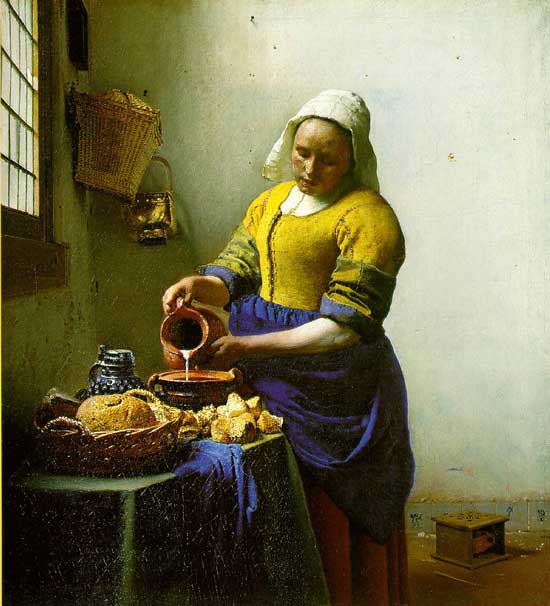What Effects Are Created by Complementary Colors in Art

Vincent Van Gogh, Café Terrace on the Place du Forum, Arles, 1888.
Complementary colours
Two colours, placed side past side, volition appear differently depending on which colours are used and what they are placed side by side to.
The effect of this interaction is called simultaneous contrast.
Simultaneous dissimilarity is most intense when two complementary colours are juxtaposed directly adjacent to each other.
For example, red placed directly next to a green, if yous concentrate on the border y'all will see a slight vibration.
Your centre doesn't like resting on the border. The two complementary colour in their purest, virtually saturated form don't sit down well together, however, if yous want to endeavor and focus your viewer gaze on a detail office of the painting a knowledge of the 'attraction to the eye' can be used to peachy result…
Van Gogh'south painting technique
Orange and blue accentuate each other in Van Gogh's Café Terrace on the Place du Forum, Arles, 1888 higher up.
In Van Gogh's painting, he has a very bold use of colour. If we start to analyze the piece we can run across how he has used the power of complementary colours and the color bicycle to heighten the visual effect of simultaneous contrast.
He wanted to move our optics around the painting, non but by the limerick, but by his use of complementary colour:
- The rear windows – have a very stiff saturated orange sitting right adjacent to a pure french ultramarine, this causes the shimmering consequence to give the evening window calorie-free a 'glow'.
- The forepart of the cobbles – He has used this outcome on a more subtle level where the small arches of orange and blueish add motility, reflecting the movement and life inside a buffet.
- Warm and cool colours – add a visual depth to it due to the fact that cool colour recedes into the background and warm colours come frontwards.
In this example, Van Gogh has used complementary colours to his advantage and often went out of his way to create dissimilarity and tension in his paintings.
When describing the painting below he commented to his brother Theo:
"I have tried to limited the terrible passions of humanity by ways of red and green. The room is claret crimson and night yellow with a green billiard table in the heart; in that location are four citron yellow lamps with a glow of orange and light-green. Everywhere in that location is a clash and contrast of the virtually disparate reds and greens….'

Vincent Van Gogh, The Night Café, Arles, 1888.
However, the jarring nature of this visual effect is exactly that – jarring. So, if y'all want to create a painting that is more harmonious y'all tin can yet utilise these principles but on a more subdued level.
Vermeer uses of complementary colour

Vermeer, The Milkmaid, 1658 – 60
In this Vermeer painting, The Milkmaid, we can also run across the result of complementary colours, admitting on a more subtle level.
Here he uses an approach using carve up complements which in general volition create a subtle effect.
Split Complements
This is where you lot use one colour, for example, blue and instead of using its direct complement (orange) we divide the colour wheel and use the next colour along. For this example, that would be a yellowish-orange. This creates a nice visual remainder, merely also interest for our center.
The main indicate of focus of this painting is the milk jug. Vermeer has the milkmaid's gaze looking directly at it and then nosotros naturally follow her gaze to the object.
However, he nevertheless uses this visual effect by making the focus of the painting, the jug, a warm bright orangish placed adjacent to a bright bluish of her dress to create a visual residuum.
So how can this help me in my choice of colours when painting?
If you place a strong cadmium yellow next to a gray it volition announced (to our eye) different than if it was placed directly next to its complementary color, purple.(I'm using grey every bit an example considering it is a neutral colour)
If you place a grey next to another stronger highly saturated color, the gray will appear to have a slight tint of the surrounding or adjoining color.
Creating a warm glow to your mural painting
So if you want to create the illusion of a warm sunset, the first expanse of land nearest to the horizon line can be left a muted cool colour (blue, green) so the effects of simultaneous contrast can be used to create the illusion 'glow' of the horizon. The more muted the horizon line the most natural information technology will announced. (come across: Titian's utilize of warm and cool colours)
In Turner's painting below you can run into how he has used a muted blue groundwork to emphasize the bright orange sunset.

J.Thousand.W Turner, Slave ship, 1840
Why does this happen?
The actual paint colours are of course not altered; only our perception of them changes.
The gray on the left will appear to have a slight tint of the surrounding or adjoining colour.
Whereas the edges of the xanthous square on the correct take a 'shimmer' to them.
A cursory history of simultaneous contrast
Michel Eugene Chevereaul, a French Scientist, was working every bit the director of the dye works at the Gobelins Manufactory in Paris. Whilst he was working in that location he received many complaints most the colours of the dyes, Specifically how the blacks appeared differently when used side by side to blues.
Researching this further, he realized that the yarn's 'perceived' color was existence affected by the surrounding colours. This led to the idea of simultaneous contrast.
Why does this happen?
Our perceived 'retentivity' of an object can exist very strong.
If a beginner learning how to paint places a assistant under a crimson light it would cause our logical left brain retentiveness some bug because we take such a potent memory of bananas existence yellow.
Even if we run into them as red your brain tells you, this doesn't feel right, so y'all modify the colour to something you experience more comfortable with, and so the painting looks 'wrong'.
Colours tin can be tricky.
To try and annul this event artists often use isolated swatches of paint or viewfinders to try and perceive a colour on its own, in isolation, rather than trying to approximate information technology next to another colour.
So the next time y'all are creating a painting withhold judgment on your colour mixing prowess until you have all the bordering colours side by side to each other.
I often paint thin, more muted colours to offset with and try and build upwardly the whole picture at once. It then becomes easier for the middle to guess the correct balance of a hue. I leave the strongest, thickest paint for terminal, so I can choose exactly the tone and color of the paint to pull the film together.
One of the biggest mistakes you tin can practice is working on one small-scale section to completion earlier addressing the picture show as a whole.
If yous'd like to larn more about colour mixing, you lot should accept a wait at my simple colour mixing form.
You might as well like:
How your hairdresser can teach yous to mix colours
The subconscious hues of colour mixing
Source: https://willkempartschool.com/complementary-colours/
0 Response to "What Effects Are Created by Complementary Colors in Art"
Post a Comment